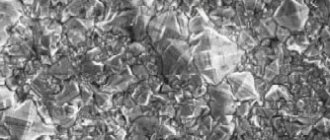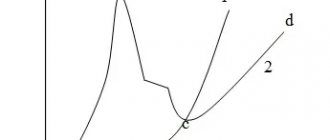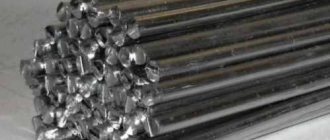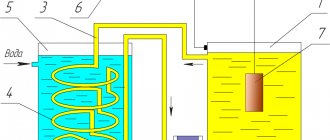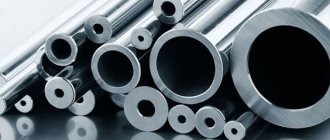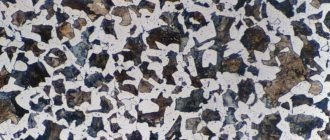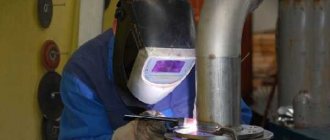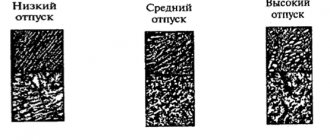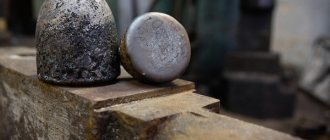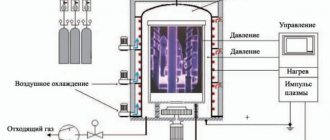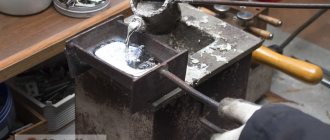What is nickel plating?
Nickel plating is the process of applying a thin layer of nickel metal to a product to give it the necessary properties.
Coatings are widely used as a sublayer when coating with precious metals, as well as to improve electrical conductivity, increase hardness, protect in alkaline environments and give a highly decorative appearance.
Nickel is a silvery-white metal with a strong luster. The atomic mass of nickel is 58.69 g/mol, density 8.9 g/cm3. It has an electrochemical equivalent of 1.095 g/(A*h), its standard potential is -0.25 V.
Nickel coatings are easily passivated in air and under the influence of strong oxidizing agents. Thanks to this, the coating has high corrosion resistance. With a coating thickness of 125 microns, the base metal is already protected from the effects of industrial gases and solutions. In less aggressive environments, 50-100 microns are sufficient. Nickel is completely stable in alkalis and organic acids of an oxidizing nature.
| Designation | N. b - brilliant N - matte Nickel coating designation |
| Thickness | 6-50 microns (greater thickness is also possible) |
| Microhardness | 3420-6900 MPa |
| Electrical resistivity at 18°C | 7.23-10-8 Ohm⋅m. |
| Permissible operating temperature | 650oC |
| Light reflectance | up to 75% |
In a nickel-steel galvanic pair, nickel is the cathodic coating and, therefore, can only provide protection if there are no bare spots or pores. Therefore, it is necessary to obtain coatings with minimal porosity. In a nickel-copper pair, nickel is the anode.
The hardness of nickel obtained from electrolytes without organic additives, which include brightening agents, wetting agents and leveling additives, usually ranges from 3000-4000 MPa. With the introduction of additives, the hardness increases to 6000-7000 MPa. Tensile strength varies accordingly from 60 to 175 kgf/mm2.
Coatings have reduced ductility, but after annealing at 900°C their plastic properties are significantly improved.
There is information about the possibility of using coatings in equipment related to milk processing.
Figure 1 shows the microstructure of the surface of the matte coating on the product.
Figure 1 — Microstructure of the surface of a matte nickel coating.
Multilayer nickel plating
Used to increase the corrosion resistance of the nickel layer. It involves the sequential deposition of nickel layers, for which several solutions are used. Different layers have different properties. There are such multilayer versions of nickel coatings as bi-, tri- and sil-nickel.
Below are the prices for electrolytes of chemical nickel plating and galvanic. If the solution you need is not on this list, you can order its production according to your specifications.
| Name | Volume | Price per one. | Price for 5 units. | More than 10 units |
| Sublayer nickel plating electrolyte | 1 l. | 1200 | 1100 | 1000 |
| Nickel plating electrolyte bright | 1 l. | 1600 | 1400 | 1300 |
| Electrolyte nickel plating matt gray | 1 l. | 1200 | 1100 | 1000 |
| Electrolyte nickel plating black | 1 l. | 1400 | 1300 | 1300 |
| Chemical nickel plating acid electrolyte | 1 l. | 1000 | 900 | 900 |
| Alkaline electroless nickel plating electrolyte | 1 l. | 1000 | 900 | 900 |
Gordienko Anastasia Vadimovna Author of the materials Position: chief technologist of 6 Micron LLC Education: higher Experience in galvanizing: 13 years
When placing an order online, get a 10% discount!
Our priority is an individual approach to each order and the quality of the work performed!
Send a request or ask a question:
5/5 — (30 votes)
Electrolytes for application.
For nickel plating, sulfate, chloride, sulfamine, borofluoride, oxalate and other electrolytes are used, in which nickel is in the form of a divalent cation. A large number of compositions and deposition modes have been developed that make it possible to obtain nickel deposits with various physical and chemical properties.
Watts' sulfate electrolyte is most often used, since the substances it contains are the most accessible, and it is easy to prepare and maintain.
The main component of the sulfate electrolyte is nickel sulfate NiSO4•7H2O. Technical nickel sulfate grade CH-1 is green crystals. Solubility without heating reaches 300 g/l.
In addition to nickel salts, which are sources of nickel cations, the electrolyte contains components designed to increase electrical conductivity, stabilize acidity (buffer additives), improve the solubility of anodes (chlorides), add shine to deposits, and prevent various defects encountered during nickel plating.
If the concentration of NiSO4•7H2O does not exceed 300 g/l, Na2SO4•10H2O and MgSO4•7H2O are sometimes added to the electrolyte to increase electrical conductivity. Sodium sulfate has significantly greater electrical conductivity, but magnesium is included in nickel coatings, making them softer and lighter.
Boric acid is the most widely used buffer compound. Boric acid regulates the pH not only in the total volume of the electrolyte, but also in the near-cathode layer, in which the pH level continuously increases due to discharge and hydrogen release. At pH>4, precipitation occurs through the film of the resulting nickel hydroxide. For low pH electrolytes, fluoride additives are more effective.
Increased service life of nickel plating
Nickel plating can be subject to continuous surface corrosion. The corrosion process appears only in the initial period. As the temperature of the working solution increases, surface corrosion penetrates deep into the material. Then this process slows down and stops completely.
Copper plating of the key
To increase the service life of the nickel coating, copper plating technology is used. Copper plating can also eliminate minor surface defects. The application of copper as a substrate ensures the reliability and durability of nickel protection.
The porosity of the copper coating causes the destruction of the protective layer and reduces the service life of the finished product. The substrate metal undergoes corrosion, followed by peeling of the protective layer.
Most often, products with a single-layer protective coating are exposed to corrosion processes. Multilayer parts are exposed to harmful factors to a lesser extent.
To protect products from damage, a number of additional measures are taken. Special additives are used to close the pores.
For your information. To prevent loss of hardness, nickel plating of steel is carried out at a temperature of 250-300ºС.
Additional processing of parts to extend service life
Nickel plating at home is carried out using the following methods:
- The dry magnesium oxide reagent is mixed with water until it turns into a paste. The resulting mass is carefully processed and the part is immersed for several minutes in 50% hydrochloric or sulfuric acid.
- The working surface is wiped with penetrating lubricant. The product is then immersed in purified fish oil. Excess fat is removed after 24 hours using gasoline or other solvents.
- Larger parts are treated with fish oil in two passes. The interval between treatments should be at least 12 hours. After two days, excess slave fat is removed.
Installation diagram for nickel plating at home
The use of nickel alloys with other metals can improve the physical and chemical properties of nickel.
Aluminum helps increase the electrical resistance and corrosion resistance of nickel.
Tungsten, molybdenum and titanium increase its heat resistance.
The addition of chromium increases the resistance of the nickel coating in oxidizing and reducing solutions.
Copper increases nickel's resistance to various acids.
Cathodic processes during electrodeposition.
Electrodeposition of iron group metals from solutions of simple salts has a number of features compared to other metals. The discharge of metal ions occurs at high cathodic polarization and low hydrogen overvoltage, which creates certain difficulties, since hydrogen is released at the cathode simultaneously with the metal:
Ni2+ + 2e- → Ni0
2H+ + 2e- → H2
Förster made a major contribution to the study of the kinetics of nickel electrodeposition. He and his co-workers found that the polarization curves of deposition of metals of the iron subgroup are logarithmic in nature. In this case, significant cathodic polarization is observed even at low current densities.
Initially, it was believed that nickel deposition potentials depended on the pH of the environment—as the pH decreased from 5 to 2, the potentials should have become increasingly negative.
Glaston denied these assumptions. He found that in a buffered solution of nickel sulfate, the polarization curves always slowly rise to -0.57 V, and then rise sharply. Experimentally, at 15°C, from a 1N solution of nickel sulfate, the metal begins to precipitate on the copper cathode precisely at -0.57 V. At other temperatures, the potential for nickel release shifts to a more negative region. According to Glaston, pH does not affect the potential for nickel release. When pH decreases from 5, only a shift in the sharp rise in the polarization curve (the beginning of metal release) to higher values of current density is observed. This fact turned out to be similar for iron and cobalt.
Thus, Glaston concluded that during the deposition of nickel the process is not controlled by a slow discharge. In his opinion, significant cathodic polarization is observed only before the precipitation of the metal begins; subsequently, the polarization slightly exceeds that which occurs during the deposition of lead or copper.
All of the above is illustrated in the polarization curves in Figure 2.
Figure 2 - Polarization curves in a 1N solution of nickel sulfate at different pH values. Temperature 15o C: 1 - 0.5N sulfuric acid; 2 - pH = 2.8; 3 — pH = 4; 4 — pH = 5; 5 - pH = 6.
An increase in temperature naturally reduces polarization. On the curves this is expressed in a steeper course (Figure 3).
Figure 3 - Polarization curves in a 1N solution of nickel sulfate. Temperature 95o C: 1 - pH = 2.8; 2 — pH = 4; 3 — pH = 5; 4 — pH = 6; 5 - pH = 6 (nickel-free).
It can be seen that in solutions the cathode potential, after reaching a value of -0.57 V, changes slightly further with increasing current density. At the same time, in the absence of nickel ions in the solution, no break in the polarization curve is observed. When replacing sulfates with acetates, chlorides or nitrates, the break potential of the polarization curve remains unchanged (-0.57 V at 15o C). A change in the nickel concentration in the solution by 0.01N resulted in a potential shift of -0.06V. A change in temperature to 55°C shifted the kink potential to -0.43 V, and an even greater increase in temperature (up to 95°C) shifted the kink potential to an even more positive region (up to -0.29 V). Thus, according to Glaston, at temperatures of 15o, 55o, 95o C cathodic polarization, the polarization at the initial moment of nickel release is 0.33, 0.19 and 0.06 V, respectively, and the pH value does not affect the potential of metal release. However, as the pH decreases, the current density at which this potential is reached significantly decreases (which contradicts Kolshuter's theory).
Glaston, in addition to studying polarization during nickel deposition, was the first to notice that electrolytic nickel is deposited in a very nonequilibrium form, different from metallurgical one.
Förster drew attention to the fact that Glastnom made a significant mistake - the potential values for a given current density were recorded on the basis of short-term observations, during which these potentials were not sufficiently stabilized. In addition, not enough attention was paid to protecting the cathode space from oxygen access. Having eliminated these shortcomings, Förster managed to obtain nickel at 16°C from a 1N solution of nickel chloride at a potential of -0.42 V. In sulfate solutions, nickel began to precipitate at a potential of -0.50 V, i.e. 0.07V less negative than Glaston indicated. The nature of the anion according to Förster influenced the potential for nickel release—in sulfuric acid solutions it turned out to be more negative.
Further studies carried out by Thompson in a standard nickel bath in the presence of various foreign salts showed the dependence of the course of the polarization curves on the composition of the introduced salts (Figure 4).
Figure 4 - Polarization curves in normal nickel solutions in the presence of other salts: 1 - standard bath of 1N nickel sulfate, 0.25N ammonium chloride, 0.25N boric acid; 2 - standard bath at 5o C; standard bath + 0.25N sodium fluoride; 4 - standard bath + 0.50N sodium citrate; 5 - standard bath + 1N sodium citrate; 6 - standard bath + 1N sodium tartrate; 7 - standard bath + 1N sodium acetate; 8 - standard bath + 1H NaH2PO4.
Cathode polarization has a noticeable effect on the structure of the electrolytic deposit and on the uniformity of metal distribution on the cathode surface. From this point of view, the cathodic polarization should be raised as much as possible. In some cases, without noticeable cathodic polarization, the process does not proceed at all.
Carrying out electroless nickel plating at home
Chemical nickel plating at home is carried out using working solutions. Depending on the amount of dry reagents, the rate of increase in the nickel layer is 80 µm/h or more.
The working solution contains the following reagents, g/l:
Physical methods of applying metal coatings
- nickel sulfate (nickel sulfate powder) – 20;
- galena (lead sulfide powder) – 20;
- sodium acetate – 15;
- sodium hypophosphite solution – 25.
The operating temperature of the chemical solution is 90°C. When the lead reagent is removed, the reaction rate decreases to 50 µm/h or less.
When the operating temperature is reached, the workpiece is lowered into the container with the solution. Before nickel plating, the coating is cleaned and degreased.
The product is kept in the working solution for 1 hour. As it evaporates, add distilled water.
Upon completion of the process, the part is removed and washed in warm water. After rinsing, the product is thoroughly dried. If necessary, polish thoroughly.
Chemical processes of anti-corrosion protection of parts
Anodic processes during electrodeposition.
The mechanism of dissolution of nickel anodes is schematically expressed by the reaction equation:
Ni0 → Ni2+ + 2e-
Nickel anodes are prone to passivation. Passivation of anodes leads to a violation of the composition of the electrolyte (nickel will be produced, and acidity will increase). The passive state of the anodes is maintained by slightly soluble nickel salts formed on their surface when the permissible anodic current density is exceeded. From the moment passivation begins, the anode becomes more and more electropositive and the reaction begins:
Ni - 3ē → Ni3+
Trivalent nickel ions are hydrolyzed:
Ni3+ + 3OH- → Ni(OH)3 Ni(OH)3 → Ni2O3 + H2O
The resulting dielectric Ni2O3 promotes even deeper passivation. The passivation current density depends on the concentration of sulfate and chloride ions. Complete passivation leads to the release of oxygen and chlorine at the anode. The anodic process during nickel plating is discussed in more detail in the article.
Influence of electrolysis mode on coating quality and current efficiency.
The properties of nickel coatings are greatly influenced by:
- Bath composition;
- Temperature;
- pH;
- Current density;
- Foreign impurities.
5.1 Influence of electrolyte composition on the properties of nickel coatings.
All nickel plating electrolytes are divided into the following main groups:
- Sulfate (Watts);
- Sulfamine;
- Fluoroborate;
- Chloride;
- Fluorosilicic.
In practice, the first two are most often used. The remaining electrolytes are intended for producing matte nickel at high current densities, with 100% current output, or for coating aluminum products directly by electrolysis. All of them are much less common.
Watts' electrolyte can be used to produce both matte and shiny coatings. Currently, about 80% of all nickel coatings are bright. It is also possible to obtain shiny coatings from sulfamine electrolyte with certain additives, but more often it is used to obtain matte ductile nickel with low internal stresses for electroplating or metallization of dielectrics.
The introduction of shine-forming and leveling additives into the electrolyte allows you to obtain smooth and shiny coatings straight from the bath. Bright nickel plating has a number of advantages over matte nickel:
- the labor-intensive operation of mechanical polishing is eliminated;
- metal consumption is reduced due to mechanical polishing on corners, edges and edges;
- the number of technological operations is reduced and conditions are created for automation of the entire technological cycle;
- the deposition process is intensified due to the use of higher current densities.
The main disadvantages of shiny coatings compared to matte ones are strong hydrogenation, the presence of increased internal stresses and a large number of impurities that impair mechanical properties.
The current efficiency in a sulfate electrolyte increases with increasing concentration of nickel ions in the electrolyte.
The effect of chloride concentration on the physical and mechanical properties of nickel coatings is shown in Figure 5.
Figure 5 - Effect of chloride concentration on elongation, internal stress, hardness and tensile strength of electrodeposited nickel from Watts electrolyte solutions at pH=3.0, temperature 55°C and current density 5A/dm2.
Let us take a closer look at the effect of additives in the nickel plating electrolyte. All additives to the nickel plating electrolyte are divided into shine-forming, anti-pitting (wetting), leveling, and electrically conductive. They can be of both organic and inorganic origin. Many additives are not used today as they are obsolete (phthalimide, formalin, chloramine B, etc.).
5.1.1 Brightening agents in nickel plating electrolyte.
According to one of the accepted classifications, shine-forming additives are divided into two classes:
- Weak shine formers (class I)
make it possible to obtain shiny coatings only on a polished surface; their shine is inversely proportional to thickness. They do not affect cathodic polarization. These include methenamine, saccharin, chloramine B, disodium salt of naphthalene-1,5-disulfonic acid and others. - Strong shine formers (II class)
help to obtain shine not only on polished, but also on matte surfaces, and the shine does not depend on the thickness of the coatings. They increase cathodic polarization and level out the microrelief, but worsen the mechanical properties of deposits. These include coumarin, thiourea, 1,4-butynediol and others.
It has been established that brightening agents of the second class, especially those with double and triple bonds, are, as a rule, hydrogenated during electrolysis, and the sulfo groups of brightening agents of the first class are ultimately reduced to sulfide. Nickel sulfide, when included in the sediment, deactivates the catalytic centers of nickel, slows down the parallel reaction of the discharge of hydrogen ions and the hydrogenation processes of brighteners, and reduces the hydrogenation of sediments. This explains the advantageous use of both strong and weak shine formers.
Currently, among the brighteners, butynediol-saccharin binders are most often used due to the fact that their behavior has been best studied, and methods for purifying the electrolyte from the decomposition products of these additives have been developed.
5.1.2 Leveling additives.
Leveling additives, being surfactants, block protruding parts of the surface, and therefore deposition occurs in microcavities. Leveling additives include, for example, NIB-3. Some strong shiners also have a leveling effect.
5.1.3 Wetting agents.
Nickel plating is characterized by a phenomenon called pitting. Bubbles of hydrogen gas are retained on the cathode surface and in these places further discharge of nickel becomes impossible. Nickel begins to discharge near the bubbles (Figure 6). Pores appear on the coating, and it loses its protective and decorative properties. The adhesion of bubbles to the cathode is facilitated by all substances that increase surface tension. Hydroxides and organic compounds, as well as their decomposition products and even dust, can have a strong impact.
Figure 6 - Scheme of pitting formation on a nickel coating.
Wetting additives help reduce the surface voltage of the electrolyte and remove dirt and hydrogen bubbles from the cathode surface. Wetting additives include isoprylnaphthalene sulfonic acid, sodium lauryl sulfate, Progress detergent, etc.
It should be noted that most wetting and shine-forming additives are sulfo compounds. During electrodeposition, nickel sulfamide is formed as a result of a series of transformations. The sulfur content in sediments in large quantities adversely affects the mechanical and corrosion properties of the latter.
5.1.4 Electrically conductive additives.
Mainly to increase the electrical conductivity of the solution and, accordingly, reduce the voltage on the bath and save electricity, inorganic salts are introduced into it. Most often it is sodium, potassium or magnesium sulfate. However, as will be said in paragraph 2.6, these additives contribute to alkalization of the near-cathode layer and deterioration of the quality of the coating.
5.2 Influence of impurities in the electrolyte on the quality of nickel coating.
Nickel deposits are very sensitive to impurities entering the electrolyte. These impurities are divided into inorganic and organic.
Inorganic impurities cause the formation of brittle, cracking deposits. In the presence of copper, the deposits become rough. Zinc impurities cause dark and even black streaks to appear. In the presence of even small impurities of lead, a dark, scaly coating is formed that easily crumbles. Of the anions, the most harmful is NO3-, which promotes peeling of coatings. Such electrolytes are unsuitable for use. Chromic acids have a similar effect.
Organic compounds cause pitting, brittleness and roughness of coatings. If the electrolyte is contaminated with organic matter, it is impossible to obtain shiny precipitates.
5.3 The influence of temperature and stirring of the nickel plating electrolyte on the quality of coatings.
As the temperature increases, the current efficiency of nickel increases, since due to the acceleration of the diffusion process, polarization decreases - the nickel deposition potential becomes more positive. In this case, the hydrogen overvoltage changes slightly. Stirring the solution has the same effect.
The effect of electrolysis temperature on the physical and mechanical properties of nickel coatings is shown in Figure 7.
Figure 7 - Dependence of elongation, tensile strength and hardness of nickel coatings on electrolyte temperature at pH = 3.0 and current density 5 A/dm2.
5.4 Influence of electrolyte pH on the quality of coatings.
Nickel ions in the electrolyte are surrounded by a shell of dipole water molecules. In the electric double layer, some of the water molecules come off. Dehydration of the last water molecules requires energy, which is manifested by an increase in overvoltage, called chemical polarization. In this case, the equilibrium potential of nickel even at low current densities becomes negative.
At low pH values <1-2, nickel is almost not deposited and only hydrogen is released at the cathode. As the pH increases, the potential for hydrogen evolution becomes more negative and conditions are created at the cathode for the joint evolution of hydrogen and nickel. In this case, the higher the pH, the lower the proportion of hydrogen evolution. At high pH values, nickel precipitation cannot be carried out, since hydrolysis begins. Hydrolysis products (nickel oxide and hydroxide), penetrating into the coating, help retain hydrogen bubbles on the cathode surface, so the deposited nickel becomes porous, rough and dark. At very high pH values, a green precipitate of insoluble nickel salts can be seen on the parts with the naked eye.
Solid, stressed sediments are formed at pH >5.5, especially at temperatures below 20 °C. An increase in temperature leads to a slight decrease in internal stresses. Sediments obtained at low pH values are softer and more elastic.
The effect of pH on the physical and mechanical properties of nickel coatings is shown in Figure 8.
Figure 8 - Effect of pH on internal stress, tensile strength, ductility and hardness of nickel electrodeposited from Watts electrolyte at a temperature of 55° C and a current density of 5A/dm2.
5.5 Influence of current density and its shape on the quality of coatings.
Increasing the current density within specified limits helps reduce internal stresses and increase the gloss of coatings. The higher the temperature, the wider the operating range of current densities. It should be remembered that when the current density is significantly increased, the coating changes from fine-crystalline (compact) to dendritic (powdery) due to a violation of the stability of the flat growth front of the deposit.
The effect of current density on the physical and mechanical properties of nickel coatings is shown in Figure 9.
Figure 9 - Effect of current density on internal stress and hardness of nickel electrodeposited from Watts electrolyte at pH=3.0 and temperature 55° C.
Promising today is the use of non-stationary modes of electrolysis and ultrasound. Nickel plating with current reversal and ultrasound exposure is carried out in sulfate electrolytes. Nickel can be passivated by anodic polarization, so deposition is carried out with short anodic pulses or intermittent current. This results in the activation of nickel during the plating process. Reversing and interrupting the current ensures the production of coatings with low porosity, low internal stresses and high protective properties.
The sequential use of asymmetrical and direct current has a positive effect. Direct current deposition can improve the shine and hardness of nickel coatings.
Electrodeposition of nickel by pulsed current makes it possible to obtain mirror-shiny coatings from conventional nickel plating electrolytes without the use of shine-forming additives.
The application of ultrasound, as well as the combined use of ultrasound and reverse current, can significantly intensify the electrodeposition process. At the same time, the permissible deposition current density increases, electrolytes of conventional composition produce light, durable and practically pore-free deposits with very small coating thicknesses, at the same time the gloss of the coatings improves, and internal stresses are reduced.
To use non-stationary electrolysis modes, it is necessary to use rectifiers with special functions.
5.6 Comparison of physical and mechanical properties of nickel coating layers obtained under different conditions from Watts electrolyte and sulfamate solution.
Figure 10 - Schematic illustration of the influence of the above-described parameters of nickel deposition from Watts electrolyte and sulfamate solution on the physical and mechanical properties of the coating.
P _ ~U7 ■ O, OS LV
tce L/~, is the volume of sulfuric acid solution taken for titration, cm3;
0.05 is the molar concentration of sulfuric acid solution, mol/da3;
~V~ is the volume of barium chloride solution consumed for titration, cm3.
2.6.3.2. To prepare a chromatographic column for operation, a canopy of cation exchanger weighing 5 g is filled with water in a glass beaker and left to swell for 1 hour. Then it is transferred to the column so that the height of the resin column is 8-10 cm3. Through
P.66
3"k 213. 2У1ГГ Tmv rv-n
OST £3
With. 14
the column is passed through 30-40 cm3 of 3 K hydrochloric acid solution at a rate of 2-3 cm3/min and then the resin is washed with small portions of water until the wash water is neutral. The washing liquid in the column is lowered to the upper level of the resin and the flow is turned off using a tap. The resin should be used 3-4 times, after which regeneration is carried out, i.e. converted again to the H*-form, as indicated above.
2.6.4. Requirements for performing measurements.
2.6.4.1. Pipette 10 cm3 of electrolyte into a 100 cm3 volumetric flask, add water to the mark and stir. Pipette 10 cm3 of the resulting solution into an ion exchange column and pass the solution through it at a speed of 2 cm3/min. After the liquid level drops almost to the upper boundary of the resin, sulfate ions are washed out of the column by 40-50 cm3 of water, passing in small portions.
The eluate and washing waters are collected in a conical flask, a solution of magnesium acetate is added to pH 3-3.5, 2-3 drops of alizarin red solution, 40 cm3 of ethyl alcohol (or acetone) and titrated with a solution of barium chloride until the color of the solution changes from yellow to pink .
2.6.5. Requirements for calculating measurement results.
2.6.5.1. The mass concentration of sodium sulfate 10-water in g/dm3 is calculated using formula (7)
Influence of operating conditions of coatings on their properties.
Figure 11 — Effect of operating temperature on tensile strength, yield strength and elongation of electrodeposited nickel.
Figure 12 - Effect of deposit thickness and internal stresses on the 100 million cycle fatigue life of nickel-plated AISI 4340 stainless steel.
